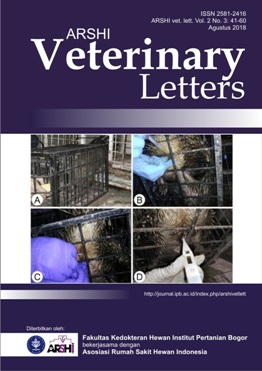Radiografi sebagai alat penunjang diagnosa dan kontrol persembuhan laminitis pada kuda
Abstract
Laminitis is an inflammation of hoof lamina which support the pedal bone to stay to it normal position. One crossbreed horse was found severely lame and lying down most of the time. Lameness examination was showing bilateral lameness of his fore hooves. Both are pain on the hoof test and digital pulse was positive. First X-ray were taken and show rotation and abnormal tip of the pedal bone, where the left fore was worse. Hoof trimming, corrective shoeing, sistemic and oral anti-inflammatory, cold compress, feeding program were combined for the treatment. Three months later, the horse was reexamined and x ray was taken. Another trimming and shoeing were followed with series of x ray shown good result. There are many different method have been suggested to provide support for an unstable pedal bone. Hoof wall resection and corrective sole on the heel area for corrective shoeing. Horse was trotted sound and starts his lower level of work few months after. X ray may identify the rotation angle of pedal bone and their effect to the bone also guide the treatment of laminitis.Downloads
References
Belknap JK. 2017. Laminitis in Horses (Founder). http://www.msdvetmanual.com/musculoskeletal-system/lameness-in-horses/laminitis-in-horses.
Hickman J, Humphrey M. 1994. Hickmans Farriery. Second Edi-tion. Hollen Street Press: London.
Morrison S. 2004. Foot management. Clinical Techniques in Equine Practice. 3(1): 71-82
Rose RJ, Hodgson DR. 2000. Manual of Equine Practice. 2nd Edi-tion. W.B Saunders.
Ross MW, Dyson SJ. 2010. Diagnosis and Management of Lame-ness in the Horse-E-Book. Elsevier Health Sciences
Copyright (c) 2018 CC-BY-SA

This work is licensed under a Creative Commons Attribution-ShareAlike 4.0 International License.
Authors who publish with this journal agree to the following terms:
1. Authors retain copyright and grant the journal right of first publication with the work simultaneously licensed under a Creative Commons Attribution License that allows others to share the work with an acknowledgement of the work's authorship and initial publication in this journal.
2. Authors are able to enter into separate, additional contractual arrangements for the non-exclusive distribution of the journal's published version of the work (e.g., post it to an institutional repository or publish it in a book), with an acknowledgement of its initial publication in this journal.
3. Authors are permitted and encouraged to post their work online (e.g., in institutional repositories or on their website) prior to and during the submission process, as it can lead to productive exchanges, as well as earlier and greater citation of published work (See The Effect of Open Access).


.jpg)















